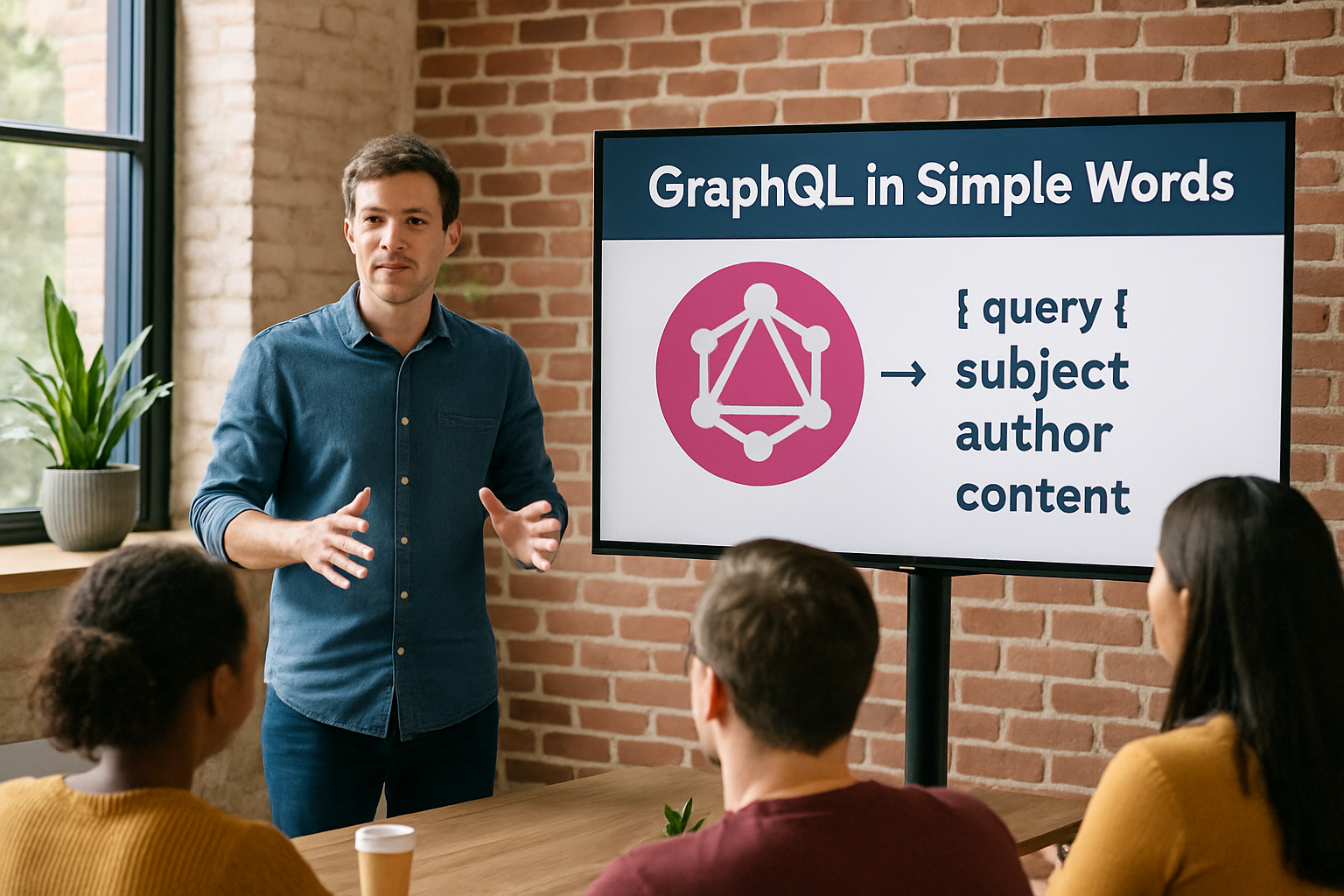
GraphQL in simple words
In the ever-evolving landscape of technology, the ways we interact with data are constantly being refined. GraphQL is one of those innovations that has fundamentally shifted how developers and organizations think about requesting and managing information. Although its technical underpinnings can seem daunting at first glance, at its core, GraphQL is about making data access simpler, more efficient, and more tailored to the needs of the individual or application. For anyone interested in technology, especially those exploring careers in IT or education, understanding the difference between GraphQL and REST is essential.
Why Do We Need GraphQL?
To appreciate the significance of GraphQL, it helps to start with what came before: REST (Representational State Transfer). For years, RESTful APIs have served as the backbone for web and mobile applications, providing a standardized way to request and modify data. REST works by exposing endpoints—each representing a specific resource, such as /users or /posts.
However, as applications have grown in complexity and the demand for real-time, personalized experiences has increased, RESTful approaches have started to reveal their limitations. Too often, REST APIs either provide too much data or not enough, leading to over-fetching or under-fetching problems. Imagine an app that only needs a user’s name and email, but the API endpoint returns a whole user profile, including address, phone number, and preferences. This inefficiency may seem small at first, but it compounds across millions of requests, especially on mobile devices where bandwidth and battery life are precious.
GraphQL was created to enable clients to ask for exactly what they need—nothing more, nothing less.
Understanding GraphQL: The Basics
GraphQL is not a database or an alternative to databases. It is a query language and a runtime for fulfilling those queries with existing data. Developed by Facebook in 2012 and released publicly in 2015, GraphQL’s core promise is flexibility: clients specify exactly which fields they want in a single request. The server responds with a precise, predictable structure, eliminating under- and over-fetching.
Queries: Asking for Data
At the heart of GraphQL are queries. These are requests that allow clients to define the structure of the response they want. Instead of calling multiple endpoints as with REST, you send a single query describing all the data your component needs.
For example, if you want to fetch a user’s name, email, and a list of their recent blog posts, a GraphQL query might look like this:
{
user(id: “123”) {
name
posts(limit: 3) {
title
publishedDate
}
}
}
The response will mirror the shape of the query, returning only the requested fields. This is a significant shift from REST, where you might need to make several calls: one to get the user, another for posts, and perhaps filter or process the results on the client side.
Mutations: Changing Data
While queries are for retrieving data, mutations are for writing or updating. Mutations in GraphQL allow clients to send instructions for creating, updating, or deleting data. The format is similar to queries, but the intention is to change something on the server.
Suppose you want to create a new blog post. A GraphQL mutation might look like:
mutation {
createPost(input: { title: “GraphQL Basics”, content: “…” }) {
id
title
author {
name
}
}
}
This mutation returns the newly created post, including the fields you specify. Instead of guessing what the server will send back, you define it as part of the mutation. This makes client development more predictable and efficient.
Contrasting GraphQL and REST
Endpoints vs. Single Entry Point
One of the most apparent differences between REST and GraphQL is how they structure their APIs. RESTful APIs expose multiple endpoints, each corresponding to a resource or action. In contrast, GraphQL exposes a single endpoint for all queries and mutations. This single entry point simplifies API management and versioning.
With GraphQL, you no longer need to track dozens of endpoints or worry about breaking changes when adding new data fields.
Over-fetching and Under-fetching
As mentioned earlier, REST’s resource-based approach can lead to over-fetching—getting more data than needed—or under-fetching—not getting enough in a single request. Developers often resort to making extra calls or writing additional code to clean up responses.
GraphQL’s hierarchical, client-driven queries solve this elegantly. The client asks for exactly what it needs, and the server responds accordingly. This is particularly beneficial for mobile apps or environments where bandwidth is constrained.
Versioning and Evolution
REST APIs often require versioning. When you need to add or remove fields, you might create /v1/users, /v2/users, and so on. This can lead to maintenance headaches and confusion for developers consuming the API.
GraphQL offers a more graceful path for API evolution. New fields can be added to the schema without affecting existing queries. Old fields can be deprecated and eventually removed, all while keeping the API backward-compatible.
Practical Benefits for Diverse Learners
Why GraphQL Matters for Neurodiverse and Nontraditional Learners
The clarity and predictability of GraphQL can be especially empowering for neurodiverse learners and those who thrive with structure. The explicitness of a GraphQL schema—defining exactly what data is available and how it can be queried—reduces ambiguity and cognitive overhead.
Students on the autism spectrum or with ADHD, for example, often benefit from systems that minimize surprises and offer clear, logical flows. GraphQL’s typed schema and introspection features allow learners to see what is possible in real time, supporting self-directed exploration and building confidence in their technical abilities.
Empowering Women and Underrepresented Groups in Tech
The tech industry has long struggled with inclusivity. For women and other underrepresented groups, navigating complex, poorly documented APIs can be a barrier to entry. GraphQL’s approach—clear schemas, self-documenting APIs, and flexible queries—reduces friction for newcomers and experienced developers alike.
Mentorship and peer collaboration are also enhanced. With a single source of truth (the GraphQL schema), teams can more easily onboard new members, share knowledge, and iterate on features. This democratizes access to data and lowers the learning curve, which is especially valuable for those balancing careers, parenting, or nontraditional learning paths.
Modern Development with GraphQL
Front-End and Back-End Harmony
GraphQL fosters a more collaborative relationship between front-end and back-end developers. Because the client defines its data requirements, back-end teams no longer need to anticipate every possible use case or create custom endpoints for every new screen or feature. This reduces miscommunication and enables rapid iteration.
For front-end developers, GraphQL tools like Apollo Client or Relay provide powerful integrations, including real-time updates, caching, and type safety. These tools help developers build more robust, responsive applications without reinventing the wheel.
Real-World Examples
Major companies and startups alike have adopted GraphQL for its productivity and performance benefits. GitHub, Shopify, Twitter, and Airbnb use GraphQL to power mission-critical applications, streamlining the way their teams build and scale products.
For educators and learners, open-source GraphQL APIs—like the GitHub GraphQL API—offer a playground for experimentation and growth. By exploring these APIs, students can see the power of structured queries and practice building real-world integrations.
Challenges and Considerations
While GraphQL offers many advantages, it is not a panacea. Implementing GraphQL can be complex, especially for teams new to the paradigm. Performance concerns can arise if queries become too broad or complex, and securing a flexible API requires careful thought.
Documentation and onboarding are essential. Although GraphQL encourages self-documenting schemas, teams must invest in clear communication and robust tooling. As with any technology, the human element remains crucial: empathy, patience, and a commitment to inclusion will make the difference between a good API and a great one.
GraphQL’s strength lies in its adaptability—its ability to serve a diverse set of users and needs without sacrificing clarity or predictability.
Looking Forward
The world of APIs is richer and more exciting than ever before. GraphQL represents a leap forward in how we think about data, collaboration, and user empowerment. For anyone curious about technology, from students exploring their first lines of code to experienced engineers seeking new efficiencies, GraphQL is a powerful tool to add to your toolkit.
As our digital experiences become more personalized and interconnected, the demand for APIs that are both flexible and accessible will only grow. GraphQL’s design philosophy—putting the client in control, embracing transparency, and fostering collaboration—offers a blueprint for the inclusive, innovative future of technology.
Whether you are building the next big app, teaching others to code, or simply exploring the boundaries of what’s possible, understanding GraphQL will open up new avenues for creativity, efficiency, and connection. And in a world that’s always changing, that skill is more valuable than ever.


